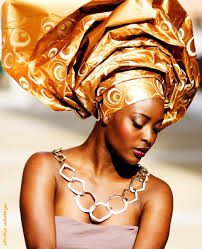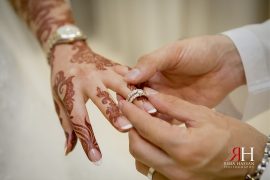
The Gele is a traditional Nigerian head wrap. It is worn during special occasions as an accessory to the traditional ‘iro’ (a wrap-around skirt) and ‘buba’ (a loose fitting blouse). Gele is usually made out of heavy or stiff fabric that can be wrapped and molded into a specific shape. Fabrics from Switzerland and Austria are very popular, but the most popular and indigenous to the Yoruba is the ‘aso oke.’ Aso oke is originally a ceremonial fabric woven locally in Nigeria and is made up commonly of strands of cotton and/or silk. Aso oke is also used to make iro and buba, but generally for very special occasions such as the bride’s wedding dress.
When I was growing up in Nigeria, the tying of the gele was always a sign of an upcoming special occasion. My mother, who admits to being inept at this admirable art, always enlisted the help of a close friend or neighbor before a party. After many failed attempts by my mother, these women would swoop in and have the gele tied in 5 minutes flat. To a skinny, six-year-old girl, there is nothing more beautiful than seeing your mother looking like a queen. The gele meant more to me than a tiara or an actual crown. It was the ultimate expression of femininity. Maybe it was the glimmering metallic of the aso oke, or the bright shades of the gele that made women look so glamorous.But it was empowering, and made me proud to be female in a society that celebrated the dominance and superiority of men.
Gele is a sign of social status and importance. It is, in essence, the Nigerian woman’s crown. In the eighties, the various comedy sitcoms in Nigeria always had a ‘business woman’ character sporting an expertly tied gele. One of such women was the character ‘Madam’ of the series, Basi & Company, created by the late Ken Saro-Wiwa. She was a woman of means, weekly falling prey to one of Basi’s ‘get-rich-quick’ schemes. She wore her gele all the time, no matter how bright or outlandish. It was a sign of flamboyant ostentation, at a time where millionaires were being made it seemed almost daily in a then 20-something year old Nigeria.
The Modern Gele
Today, the gele, much like Nigerian traditional culture, has been revamped and celebrated. An explosion of creativity, combined with our innate cultural pride means that women are treating the gele not just as an accessory but sometimes as the main focus of their attire. Gele now comes with scalloped edges, laser-cut designs, hand-beaded, two-tone effects, Swarovski encrusted, hand-painted, embroidered, sequinned, and any other design aesthetic you can dream up. Gele tying is now a service provided by most makeup artists and/or salons in Nigeria or Nigerian communities across the world.
Weddings
During the preparation for my traditional wedding ceremony, my mother, her ‘committee’ of well-versed wedding planners and I scoured hundreds of fabric samples before deciding on my gele. Even though I knew exactly what I wanted, this was necessary as the gele for your wedding is generally custom-made. Being that the groom was from a different part of the country and has his own traditions I donned two types of outfits on the day, meaning two different geles. As an ode to my own tribe, the Yorubas, I wore an “aso oke” gele (to go with the “aso oke” “iro”and “buba”) for the ceremony, as during the ceremony the groom comes to formally ask for the hand of the bride from her family. For the celebrations after the ceremony, I wore the traditional attire of my husband’s family, which required a “gele sego.” In my culture, when a woman marries, she enters into a new family and adopts their customs and traditions as her own. Wearing their attire is a way of showing my desire to adopt their culture and be part of their family.
The gele is becoming more and more significant. As more Nigerian women take pride in their culture and traditions, the attire becomes a huge part of their lifestyle. Nigerian women take great pride in their appearance, and the gele is their crowning glory. The gele can be outlandish or demure, depending on who is tying it and for what occasion it is being worn. From my mother’s conservative styles, via the comically outlandish costume of “Madam”, to our ever-fashionable crowns today, there is no doubt that the gele is a bold expression of femininity. In the 80s, Western women had the power suit, Nigerian women had the gele. This is a custom I hope never fades.
Teniola Adunni GioKabari is a Nigerian-British beauty expert living in London.




